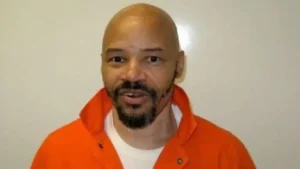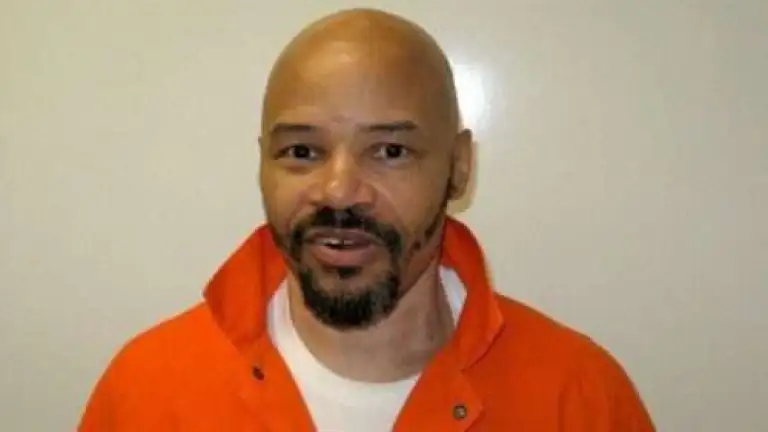Douglas Carter was sentenced to death and remains on Utah Death Row for the murder of a woman
According to court documents Douglas Carter would force his way into the home of Eva Olesen who he would then stab her to death
Douglas Carter would be arrested and give a confession however he would later say that the confession was coerced
Douglas Carter would be convicted and sentenced to death
Douglas Carter Photos

Douglas Carter FAQ
Where Is Douglas Carter Now
Douglas Carter is incarcerated at Utah State Prison
When Is Douglas Carter Execution
Douglas Carter execution has yet to be scheduled
Douglas Carter Case
On the night of February 27, 1985, Orla Oleson discovered his wife, Eva, murdered *634 in their Provo, Utah home. The medical examiner testified that Mrs. Oleson had been stabbed eight times in the back, once in the abdomen, and once in the neck. The examiner further stated that Mrs. Oleson had received a fatal gunshot wound to the back of her head. Apparently, the murderer fired the gun at point blank range through a pillow to muffle the sound. Other testimony revealed that Mrs. Oleson’s hands had been tied behind her back with a telephone cord and that her pants and pantyhose had been pulled down (or off) and lay at her feet. Her sanitary pad had been removed and also lay at her feet.
A specialist with the Bureau of Alcohol, Tobacco, and Firearms determined that the markings on the slug removed from the body were consistent with those produced by a .38 special handgun. However, the police could not locate the weapon at the murder scene. The knife used to inflict the stab wounds came from the Olesons’ kitchen and was discovered on the floor near the body.
Douglas Carter first surfaced as a possible suspect in the case in early to mid-March 1985. The police included Carter’s name on the original list of suspects for two reasons: (1) An eyewitness identified Douglas Carter as the probable perpetrator of an attempted “automobile trespass” which occurred about an hour or two prior to the murder in the same general area, and (2) the police received information that Carter’s wife, Anne, on learning of the homicide, had told someone that she rushed home to see if her husband was involved.
Following these leads, on March 14, 1985, the police met with Carter and questioned him about both the automobile trespass charge and the Oleson homicide. Although Douglas Carter admitted that he knew Mrs. Oleson[5] and could not account for his whereabouts on the night of the murder, he denied committing the crime. Carter was fingerprinted and released.
On March 20, 1985, the police again questioned Douglas Carter regarding the homicide. The police told him that they doubted his truthfulness because of some discrepancies between his and his wife’s statements. Carter asserted that he was telling the truth. The police then obtained Carter’s permission to take hair samples to compare with those found at the crime scene. The police learned a short time later that none of the hair samples taken from the Oleson residence belonged to an individual of Carter’s race, African-American. As of this date, Carter was one of about eight suspects in the homicide.
Douglas Carter did not emerge as the prime suspect until April 8, 1985, when his wife sought legal advice from Deputy Utah County Attorney Sterling Sainsbury and private attorney Robert Orehoski. On the morning of April 8, Anne Carter approached Sainsbury, whom she knew through her position as a clerk for the juvenile court, and told him that she thought her husband had been involved in the Oleson murder. According to Sainsbury, Anne Carter suspected that her missing handgun, a .38 special, was the murder weapon and she showed Sainsbury the receipt for its purchase. She feared that she would be implicated as an accessory to the crime because she owned the handgun and it was improperly registered. Finally, she mentioned that some of Carter’s clothes appeared to be bloodstained.
Sainsbury informed her that he was not her lawyer and that as a Deputy Utah County Attorney, he had a duty to report her story to the County Attorney’s Office. He then advised her to meet immediately with a private attorney and come forward with the information voluntarily. Early that afternoon, Sainsbury sought out the prosecutor assigned to the Oleson case, Deputy Utah County Attorney Wayne Watson, and related Anne Carter’s statements.
Anne Carter then approached Robert Orehoski, a private attorney who was representing her in a divorce action. Coincidentally, Watson was Orehoski’s private law partner. Anne Carter told Orehoski that Douglas Carter had given her information about the Oleson murder and that she was worried the missing handgun would be traced to her. Orehoski *635 recommended that she seek a conditional grant of immunity in exchange for her information.
The parties dispute what occurred at this point. The State claims that Anne Carter agreed to Orehoski’s proposal and requested that he contact the County Attorney’s Office. According to the State, Orehoski then contacted Watson and, without revealing Anne Carter’s identity, described the proposed deal of conditional immunity in return for information. Watson accepted the proposal and produced a signed, handwritten conditional grant of immunity which he gave to Anne Carter in exchange for her information. Carter, on the other hand, asserts that Orehoski invited Watson into his office to question Anne regarding Carter’s involvement in the murder. Carter further asserts that Anne did not understand why Orehoski wanted her to speak with Watson, but she acquiesced because of Orehoski’s representation regarding the conditional grant of immunity. As a result of Anne’s disclosure, Carter claims that the focus of the investigation shifted from Orla Oleson to Carter.
Pursuant to Anne Carter’s consent, Provo police officers searched the Carter home, hoping to discover the missing handgun. Although they did not find the weapon, they discovered several articles of clothing that appeared to be bloodstained. The officers then requested, and Anne Carter signed, a new consent warrant permitting police to search for and seize any article of evidentiary value. A search warrant was simultaneously obtained from the local circuit court. Pursuant to these new warrants, the officers seized several articles of bloodstained clothing and copper-jacketed .38 caliber ammunition similar to that used in the homicide.
Later that day, Anne Carter met with Provo police officers to give a formal statement. At first, she refused to recount the information she had given to Watson and Orehoski. However, she grew more cooperative when a new officer was assigned to take her statement and, after some hesitation, provided the following account of Eva Oleson’s murder. On the evening of February 27, 1985, Carter went to visit his friend, Epifanio Tovar. While at the Tovar residence, Carter met two of Tovar’s friends. One of the men was a recently escaped convict who held a grudge against Provo Police Chief Swen Nielsen, a relative of Eva Oleson. The three men decided to go to the Oleson residence and steal Mrs. Oleson’s gold necklace. On arriving at the Oleson home, Carter waited in the car while the other two men knocked on the door and entered. Carter did not know that Mrs. Oleson had been murdered until the men returned with blood on their clothing and one of them said “she’s dead.” Carter also told Anne that he got Mrs. Oleson’s blood on his clothes when he reached out and pulled one of the men into the car.
As a result of the information received from Anne Carter, the police identified several witnesses, including Epifanio and Lucia Tovar. The Tovars gave a very different account of the murder, stating that Douglas Carter was the sole perpetrator and even bragged of his deed. The State relied heavily on the Tovars’ incriminating testimony at trial. Anne Carter’s statements also provided authorities with the identity and ownership of the .38 special murder weapon,[6] the .38 caliber bullets taken from Carter’s possession, and Carter’s bloodstained clothing.
On April 11, 1985, a warrant was issued for Carter’s arrest for the Oleson homicide. The following day, the State filed an information charging Carter with capital murder. After fleeing from Utah authorities, Douglas Carter was located and arrested in Nashville, Tennessee. While at the Nashville jail, Carter was interviewed first by Nashville authorities and then by Lieutenant George Pierpont of the Provo City Police Department, who had been sent to extradite Carter to Utah. After receiving Miranda warnings, Carter voluntarily confessed to Lieutenant Pierpont.
The guilt phase of Carter’s trial began on December 17, 1985. The State theorized *636 that Carter acted alone in the homicide and presented its witnesses and evidence accordingly. Carter put on no live witnesses but did present two psychiatric reports for mitigation during the penalty phase.
On December 18, 1985, a jury unanimously found Douglas Carter guilty of murder in the first degree. A special verdict revealed that the jurors had found two aggravating circumstances beyond a reasonable doubt: Carter had murdered Eva Oleson while he was engaged in the commission of or an attempt to commit aggravated burglary, and the homicide was committed in an especially heinous, atrocious, cruel, or exceptionally depraved manner. The penalty phase followed a day later, and on December 19, 1985, the jury sentenced Carter to death.
https://law.justia.com/cases/utah/supreme-court/1995/920110.html
